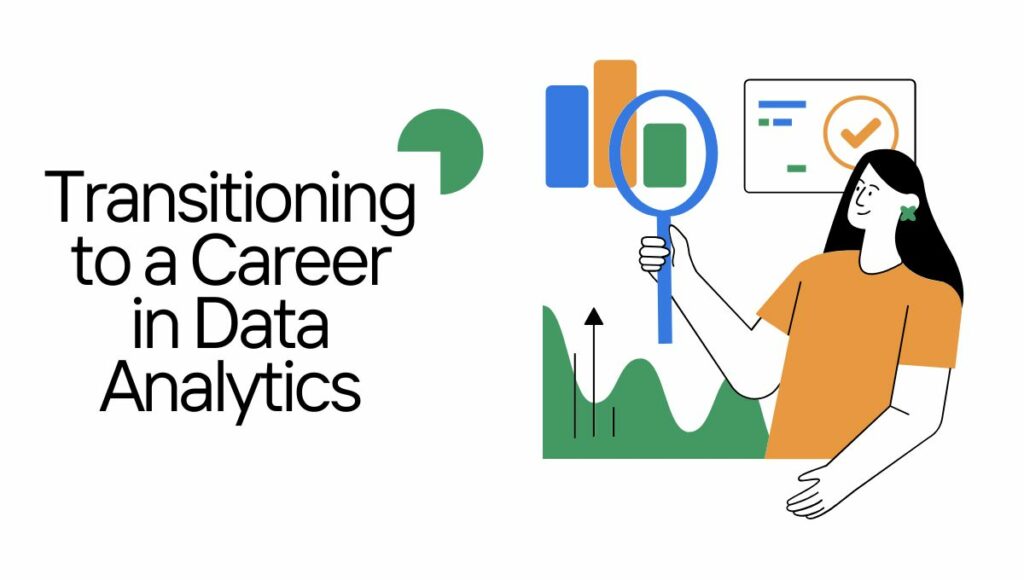Data analytics is transforming industries. Businesses rely on data to make informed decisions. Analysts help uncover patterns and insights. But how does one transition to a career in data analytics? This guide covers essential steps, skills, and career paths.
Looking to build a data career? A structured course can help. Check out Imarticus Learning’s data science course to gain the right skills and industry exposure.
What is Data Analytics?
Data analytics involves processing raw data. It helps businesses understand trends and patterns. The goal? Better decisions. Analysts use statistical techniques, software, and data visualisation tools.
Why Choose a Career in Data Analytics?
- High Demand: Companies need data experts.
- Competitive Salaries: Well-paid industry roles.
- Diverse Career Paths: Options in finance, healthcare, retail.
- Remote Work Flexibility: Many roles allow work-from-home.
- Fast-Growing Industry: Expanding job market.
How to Make a Career in Data Analytics
Transitioning requires learning new skills. Follow these steps:
1. Learn the Fundamentals
- Understand statistics and probability.
- Learn data visualisation techniques.
- Master basic SQL and databases.
2. Learn the Important Technical Skills
- Learn Python or R for analysis.
- Understand Excel and Google Sheets.
- Work with data visualisation tools.
3. Try to Get Some Hands-On Experience
- Take online projects.
- Build a portfolio.
- Work with real datasets.
4. Earn a Certification
- Join structured data analytics courses.
- Learn from industry experts.
- Gain hands-on exposure.
5. Apply for Entry-Level Roles
- Start as a data analyst intern.
- Gain experience.
- Move into advanced roles.
Career Paths in Data Analytics
There are multiple career paths in data analytics. Here are the key roles:
| Job Role | Skills Required | Best For |
| Data Analyst | SQL, Excel, Tableau | Beginners |
| Business Analyst | Communication, Data Interpretation | Business Strategy |
| Data Engineer | Python, Cloud Platforms | Data Management |
| Data Scientist | Machine Learning, AI | Advanced Analytics |
| BI Analyst | Power BI, Reporting | Dashboard Creation |
Data Visualisation Tools for Analysts
Data visualisation tools help analysts present insights. Some popular tools include:
- Tableau: Interactive dashboards.
- Power BI: Microsoft ecosystem integration.
- Google Data Studio: Free cloud-based tool.
- Python Libraries: Matplotlib, Seaborn.
- Excel: Built-in graphs and charts.
Essential Data Analytics Skills
To transition into analytics, develop these skills:
1. Technical Skills
- SQL & Databases: Querying data efficiently.
- Python & R: Essential for data manipulation.
- Data Visualisation: Present insights effectively.
2. Analytical Thinking
- Problem-Solving: Finding patterns in data.
- Critical Thinking: Making data-driven decisions.
- Attention to Detail: Ensuring accuracy.
3. Business Knowledge
- Industry-Specific Analytics: Understanding domain data.
- Communication Skills: Explaining data insights.
How to Build a Data Analytics Portfolio
Your portfolio showcases skills. Include:
- Data Cleaning Projects: Show preprocessing skills.
- Exploratory Data Analysis: Present insights.
- Machine Learning Models: If applicable.
- Data Visualisation Reports: Use interactive charts.
Common Mistakes in Data Analytics Careers
Avoid these errors:
- Ignoring Business Context: Always consider industry relevance.
- Not Practicing Enough: Work on multiple datasets.
- Lack of Communication Skills: Explain insights effectively.
- Ignoring Data Ethics: Maintain privacy and compliance.
Data Analytics Job Market Trends
The career path in big data analytics is evolving. Trends shaping the future:
- AI-Driven Analytics: Automation in insights generation.
- Real-Time Data Processing: Faster decision-making.
- Cloud-Based Analytics: Data stored and analysed remotely.
- Blockchain in Data Security: Protecting sensitive information.
Certifications for Data Analysts
Certifications help boost credibility. Popular ones include:
- Google Data Analytics Certificate: Beginner-friendly.
- Microsoft Certified: Data Analyst Associate: Power BI focus.
- IBM Data Science Professional Certificate: Covers Python, ML.
- Certified Analytics Professional (CAP): Advanced credential.
Transitioning from Non-Technical Backgrounds
Not from a tech background? You can still switch:
- Leverage Domain Knowledge: Industry experience is valuable.
- Start with Business Analytics: Less technical roles available.
- Take Structured Courses: Learn step by step.
- Use No-Code Tools: Power BI, Google Data Studio.
Data Analytics Resume Tips
Your resume should highlight key skills:
- Technical Proficiency: SQL, Python, Tableau.
- Projects & Case Studies: Showcase real-world work.
- Certifications & Courses: Display credentials.
- Work Experience (if any): Detail relevant roles.
Challenges in Data Analytics Careers
Challenges include:
- Handling Large Datasets: Requires optimisation skills.
- Interpreting Complex Data: Ensuring insights make sense.
- Staying Updated: Learning new tools regularly.
- Communicating Insights: Presenting data effectively.
Future of Data Analytics Careers
Data analytics is evolving rapidly. Future trends:
- Increased Use of AI: Automating data insights.
- Integration with Cloud Tech: Real-time processing.
- Data Privacy Regulations: Compliance is critical.
Conclusion
A career in data analytics offers immense opportunities. With the right skills, tools, and industry knowledge, success is achievable.
Want to transition successfully? Explore the Postgraduate Program In Data Science And Analytics to get started with your career path in big data analytics.
Frequently Asked Questions
How to make career in data analytics?
Learn statistics, programming, and data visualisation. Gain hands-on experience and earn certifications.
What skills are needed for data analytics?
SQL, Python, Excel, and data visualisation tools like Tableau and Power BI.
Are data analytics jobs in demand?
Yes, data analytics roles are among the fastest-growing career options worldwide.
What are the best career paths in data analytics?
Options include data analyst, data engineer, business analyst, and data scientist.









